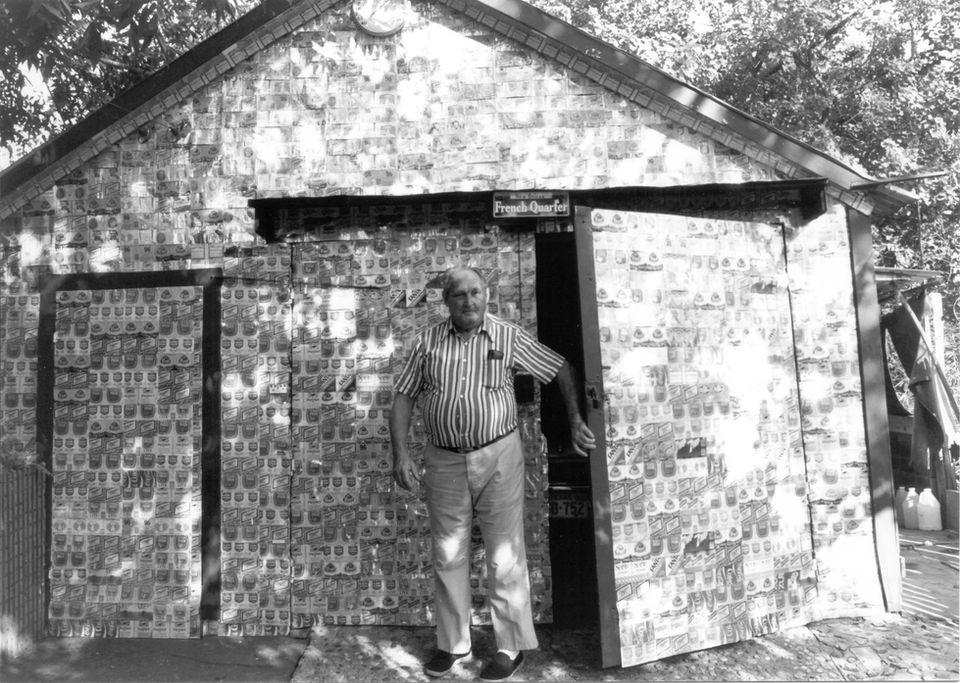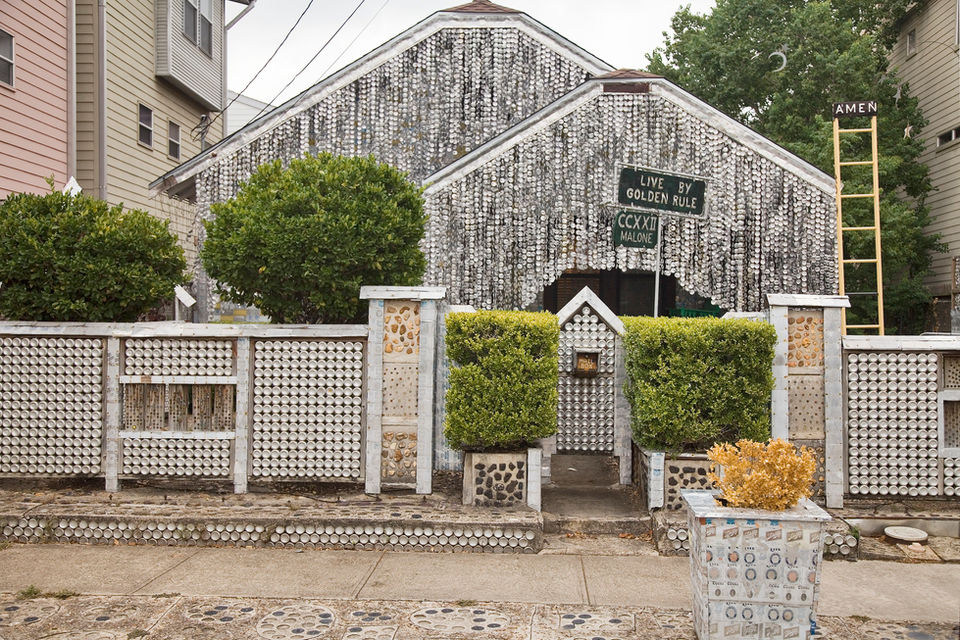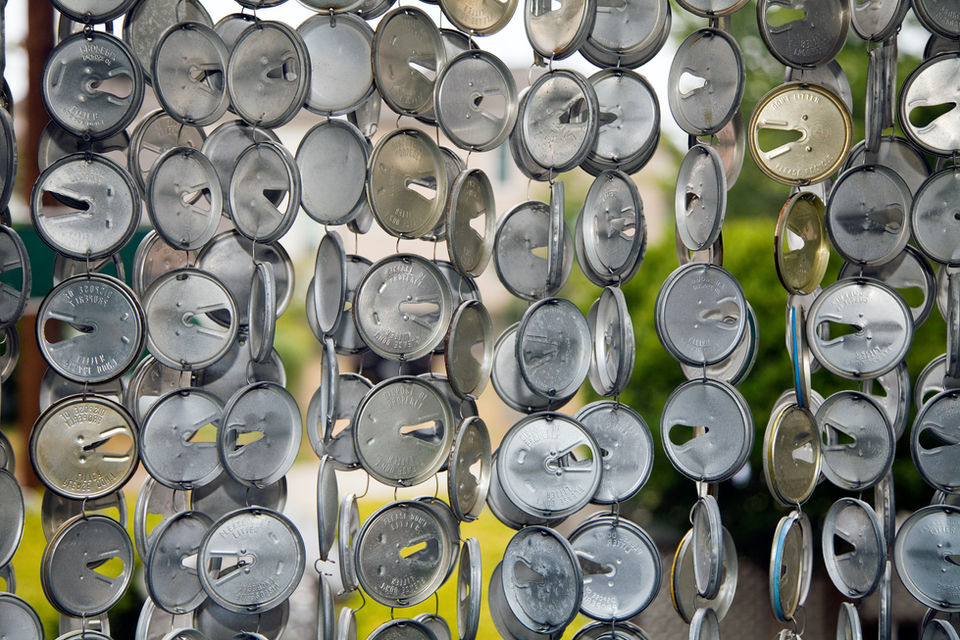The Beer Can House is currently open Saturdays and Sundays from 12-5pm
The Beer Can House is currently open Saturdays and Sundays from 12-5pm
John Milkovisch, a retired upholsterer for the Southern Pacific Railroad, started his project now known as the Beer Can House in 1968 when he began inlaying thousands of marbles, rocks, and metal pieces into concrete and redwood to form unique landscaping features. When the entire front and back yard were completely covered because he "got sick of mowing the grass", he turned to the house itself and began adding aluminum siding - aluminum beer can siding, that is.
Over the next 18 years the house disappeared under a cover of flattened beer cans for both practical and decorative reasons. Garlands made of cut beer cans hanging from the roof edges not only made the house sing in the wind, but also lowered the family's energy bills. Ripley's Believe It or Not estimated that over 50,000 cans adorn this monument to recycling.
VISIT THE BEER CAN HOUSE
THE BEER CAN HOUSE IS OPEN WEDNESDAY-SUNDAY FROM 10AM-4PM
OPEN ON BLACK FRIDAY, DAY AFTER CHRISTMAS,
CLOSED ON CHRISTMAS EVE, NEW YEARS EVE, AND NEW YEARS DAY.
ADMISSION IS FREE
Free admission to The Beer Can House is made possible by the generous support of Saint Arnold Brewing Company

For information about special group tours, click here
NOTE: The Beer Can House is a No Open Carry site. Pursuant to Section 30.07 we reserve the right to ask you to leave should you openly carry a firearm onto the premises.
UPCOMING EVENTS
DJ Morrow
on view: September 19 - 21, 2025
opening reception: September 19, 7:30 - 9pm

"The Fount of Our Despair" is a fine art balloon installation by Houston based artist DJ Morrow.
Through mysterious and sinister balloon figures, Morrow attempts to reconcile the existential threat of fascist America with our desire for villains simultaneously concrete and wholly unfathomable. On view at The Orange Show's historic Beer Can House, September 19th - 21st, with an opening reception and artist talk September 19th at 7:30pm.
Going Postal:
New Mail Art from Houston and Beyond
on view: September 28 - December 28, 2025
special event with John Held: November 16, 2025, 1 - 4 pm

PAST EVENTS
Kambel Smith
on view: February 9 - April 27, 2025
opening reception: February 9, 1 - 4 pm

Philadelphia-based artist Kambel Smith (b. 1986, Altus, Oklahoma) builds large-scale sculptural recreations of significant landmarks using repurposed cardboard and Styrofoam. With no formal training in art or architecture, Smith uses only his natural ability to gauge perspective and scale without the assistance of measuring tools, creating remarkably detailed models of such iconic architecture as the Chrysler Building, the Philadelphia Museum of Art, and the Sydney Opera House.
As a frustrated young person, Smith found relief in drawing Autisarians, which he defines as “a person born with superhuman abilities due to the condition called autism.” With family encouragement, Smith created hundreds of paintings and drawings featuring dozens of characters, published four novels, and produced an animated short. His work has been featured at the Outsider Art Fair in New York City, at the Atlanta Contemporary Art Center, and at the Philadelphia Airport, and he was the winner of a 2021 fellowship from the Pew Charitable Trust. He and his family created the Autisarian Network, a nonprofit dedicated to changing perceptions of people with autism.
THE BEER CAN HOUSE BLOCK PARTY
Quarterly Meetup for Neighbors Near and Far
For decades, the Beer Can House has been an essential part of the fabric of the Rice Military neighborhood west of downtown. With our sponsors at Saint Arnold Brewing Company, we host free quarterly block parties to meet new friends and maintain old friendships. Free libations, hands-on craft activities, and live music are all featured at this family-friendly event.
Click on a date below to sign up to attend
Sunday, September 14, 2025, 1 - 4 p.m.
Sunday, December 28, 2025, 1 - 4 p.m.
GROUP TOURS & FIELD TRIPS
The Beer Can House is a perfect place for field trips designed to explore the artist in everyone! We can custom-design an unforgettable experience that includes guided tours and hands-on workshops that will be sure to make an impact. If you would like more information about fields trips and group tours to the Beer Can House, fill out the form below and we'll contact you shortly!

HISTORY OF THE BEER CAN HOUSE
"John considered his work an enjoyable pastime rather than a work of art, but he did enjoy people's reaction to his creations."
John Milkovisch, a retired upholsterer for the Southern Pacific Railroad, started his project now known as the Beer Can House in 1968 when he began inlaying thousands of marbles, rocks, and metal pieces into concrete and redwood to form unique landscaping features. When the entire front and back yard were completely covered because he "got sick of mowing the grass", he turned to the house itself and began adding aluminum siding - aluminum beer can siding, that is. Over the next 18 years the house disappeared under a cover of flattened beer cans for both practical and decorative reasons. Garlands made of cut beer cans hanging from the roof edges not only made the house sing in the wind, but also lowered the family's energy bills. Ripley's Believe It or Not estimated that over 50,000 cans adorn this monument to recycling.
John considered his work an enjoyable pastime rather than a work of art, but he did enjoy people's reaction to his creations. He once said, "It tickles me to watch people screech to a halt. They get embarrassed. Sometimes they drive around the block a couple of times. Later they come back with a car-load of friends..."
The house and landscape are adorned with many different types of beer that John, himself, drank (though his neighbors and his wife, Mary, were always glad to lend a hand!). Did he prefer one brand to the next? His favorite beer was always "Whatever's on special."
Download the complete history of the Beer Can House HERE

BEER CAN HOUSE CONSERVATION & CRAFTS
Meets the Last Sunday of the Month from 1 - 4 pm

John Milkovisch spent countless hours of leisure time in his yard creating the Beer Can House. In John’s day, the can motif was only one aspect of his now-iconic visionary art environment. He and his wife Mary also filled the yard with plants and flowers that hung from the trees, occupied ceramic vessels, and grew in raised beds. As the neighborhood has changed, the property at 222 Malone remains a time capsule of Houston’s vernacular architecture from the early 20th century, with a surprise around every corner.
Beer Can House Conservation & Crafts is a free, open-house opportunity for community members to meet up at The Beer Can House one morning a month to learn, teach, and help maintain this important folk art landmark. Join us to pull some weeds, unravel some tangled can garlands, and learn some new restoration skills. No experience is required and all ages welcome!
Our Beer Can House Conservation & Crafts Crew meets the last Sunday of each month from 1 - 4 pm. See below for our Spring 2025 schedule and sign up to participate!
Upcoming Beer Can House Conservation & Crafts Meetup Dates
Click on a date below to sign up to attend




RESTORATION OF THE BEER CAN HOUSE

The Orange Show Center for Visionary Art acquired the Beer Can House after creator John Milkovisch and his wife, Mary, passed away. Diligent documentation and planning over the next few years determined a comprehensive plan to restore the site to its former glory.
Unfortunately, time and Houston’s climate are always fading and deteriorating John’s original art work. The Orange Show Center for Visionary Art’s intent was to carefully restore this work to its original condition where possible and to recreate artistic elements where necessary, bringing back the delightful ambiance of the site.
Volunteers from the local neighborhood, to the far reaches of Houston’s suburbs, and even across the country were an integral part of creating these new beer can elements. In 2008, the site opened to visitors for guided and self-guided tours that feature the history of the Beer Can House, the Rice Military neighborhood, John’s artistic techniques and Folk Art in Texas. Preservation of the Beer Can House is an ongoing project for the Orange Show Center for Visionary Art.
Generous support from the The Brown Foundation, Houston Endowment, The Cullen Foundation, The National Endowment for the Arts, Silver Eagle Distributors, as well as in-kind contributions from SpawMaxwell and Apollo BBC, Inc. helpied make this project a success.
Reconstruction services and supplies were donated by Spaw-Maxwell.
Beer Can House
Restoration Committee
Allen Caudle
Barbara Hinton
Caroline Huber
Douglas Newman
Fred Brecht
Gloria Perez
John Waits
Julie Birsinger
Lynn Herbert
Maria Moss
Marilyn Oshman
Marks Hinton
Stephanie Smither
Stephen Bridges
Susanne Theis
Renovation Team, Consultants, and Friends
SpawMaxwell
Apollo BBC
TGK + Associates
WhiteboardLabs
Mr. and Mrs. Siml
Rice Military Civic Club
All of our hard working volunteers
Renovation Team, Consultants, and Friends
Houston Endowment
The Brown Foundation
National Endowment for the Arts
The Cullen Foundation
Silver Eagle Distributors






























